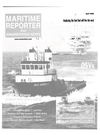
Page 41: of Maritime Reporter Magazine (April 2000)
Read this page in Pdf, Flash or Html5 edition of April 2000 Maritime Reporter Magazine
says that Caterpillar main and auxiliary engines figured prominently into the process when considering initial invest- ment, ownership cost and technology. "The Cat engines were a logical choice from every standpoint," he explains. "The initial cost of the 3516B engine is extremely competitive. Its compact size makes it easy to install in a smaller place, which allows for more cargo storage. Many competitive engines require purchasing lots of extra equipment during installation; with Cat, it's a complete package."
To determine the engine with the best lube oil and fuel consumption, Horn- beck conducted life cycle analyses between the Cat 3516 engine and a com- petitive engine. The results impressed
Annessa: Total fuel consumption per vessel has averaged between 40 to 60 gallons (151 and 227 L) per running hour with the Cat engines, about one- half the consumption of vessels fitted
Rig Repowered At
Houston Ship Repair
In a joint effort between Wartsila
NSD and Houston Ship Repair, an innovative rig was repowered in the
U.S. Gulf comprised of the installation of new gensets on Transocean Sedco
Forex's semisubmersible drilling rig
Transocean Amirante. The upgraded semi, which is now equipped with more than 8 MW generation capacity — is poised to meet future offshore challenges.
The joint-venture, which was spawned in 1998, was designed to meet the specific needs of the owner.
Work entailed schedule flexibility, as well as the possibility of quayside or offshore installation. The project began with a joint onboard survey, fol- lowed by meetings with Transocean,
Wartsila NSD and HSR to determine responsibilities and detailed planning with the competitive engine. Lube oil costs per horsepower were lower as well. And because these costs are passed on to the customer, Annessa says, it's to Hornbeck's advantage to keep them as low as possible.
With many competitive OSVs pow- ered by conventional mechanical diesel engines, Annessa found that electronic controls were another key benefit to the
Cat engines. "There's a great deal of emphasis on tradition in this industry.
It's difficult to change what people are comfortable with - they like what they know works. But I'm more comfortable with the monitoring and diagnostic capabilities of electronic engines. They alert us if there's a problem, and the built-in safeguards can limit engine damage in high load situations." The engines also produce minimal smoke — a benefit Annessa finds useful with cur- rent and pending emissions regulations.
Overall, Annessa is pleased with the
New Breed fleet and believes his cus- tomers are, too. "Our goal is to provide a high level of service at high value to the client. We give it to them by con- tracting professionally crewed, well- built, reliable boats, and the Cat engines have greatly contributed to that."
Circle 114 on Reader Service Card (continued on page 43)
April, 2000 Circle 243 on Reader Service Card 41

 40
40

 42
42
